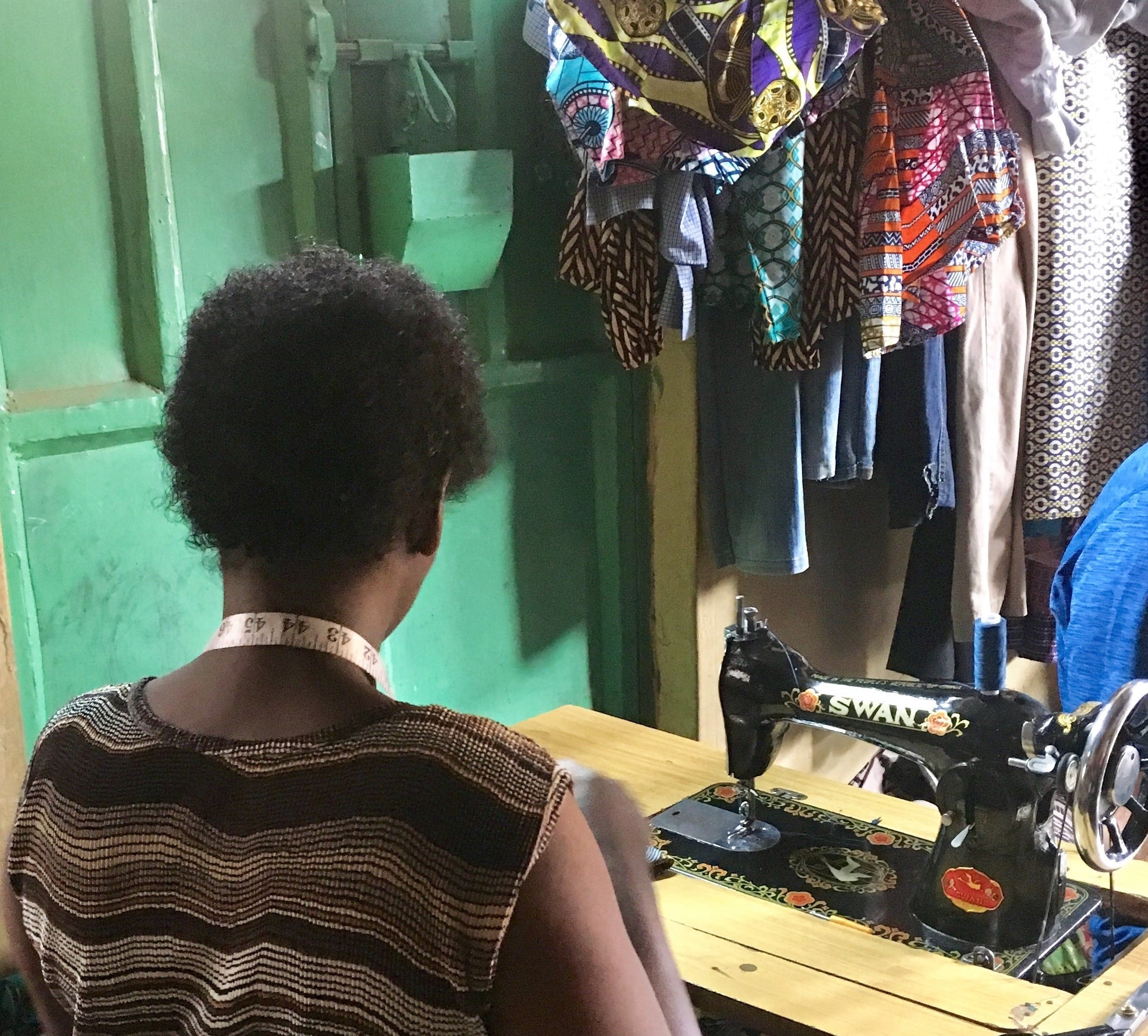Jun 27, 2019 | by Anna Ferracuti, UNCDF

“How do you like this neighborhood? That bag really suits you!” exclaims Jaqueline as she walks us to her shop. She is ecstatic because earlier today, I purchased a bag from her for KES 1,000 (approximately USD 10), an amount which is equal to the contribution she makes to her savings group every 15 days.
Jacqueline is a refugee from the Democratic Republic of Congo. I’ve met her during a field visit to a Danish Refugee Council-monitored savings group in Kasarani neighborhood, Nairobi.
The group meeting for her savings group, Isambu, ended only 5 minutes ago. Today, she deposited KES 1,000 and borrowed KES 10,000 (USD 100), which she received in no time as the interest payment (KES 500, 5%) was paid in advance. In fact, requests for loans and withdrawals from the social fund are made prior to the meeting on Isambu’s WhatsApp group. The meeting itself is just held to execute what has already been decided on WhatsApp. The money counter reports the amounts to the secretary/chairman, who registers the transaction in the individual members’ passbooks. Record aggregation occurs every three months.
The treasurer deposits in to and withdraws from the cash box, an interim solution since Isambu’s savings and social fund are kept in the treasurer’s personal bank account. It is more secure to keep money in the bank, they said. I doubt that this process is very transparent and secure.
But Isambu’s members don’t have time to waste and businesses to run, including the owners of the group’s meeting place, a grocery shop with a “milk ATM”, which is what they called the milk dispensing machine. The group’s members make a little contribution towards the shop rent to compensate for lost income while the meeting is being held.
Question for consideration: What type of socio-economic behaviors are we imagining for refugees?
Jaqueline leads us into a narrow tailoring shop (approximately 53 square feet) with eight manual and one electric sewing machine. She owns one manual machine and one electric machine; the remaining seven belong to other female tailors who share rent costs with Jaqueline.
She repeatedly tells us that she only has one employee, the one man in the laboratory, but I am not fully convinced. We definitely feel as if we are occupying someone’s spot and disrupting their work routine but nobody seems to mind.
The community facilitator from the Danish Refugee Council continues to translate Jaqueline’s story as she proudly shares her journey. She started her business in 2018 after she heard about the Isambu savings group. Joining the group allowed her to buy a used sewing machine for KES 4,000 (USD 4, ) and borrow another KES 15,000 (USD 15) to purchase the fabric. She leases the electric machine for KES 3,000/month (USD 3).
Question for consideration: What spending behaviors are prioritized in our imagination of refugees’ needs?
Last month, Jaqueline had to procure the material for a deal with a choir. Often times, clients contact her with the idea of a design and bring the fabric with them. She uses WhatsApp for advertisements and accepts payments using her husband's M-Pesa account. Although M-Pesa is not available to refugees in Kenya, seven out of eight people (all women) in this room have access to it.
We realize that the other tailors are also part of a savings group and deposit KES 500 every 15 days. They are all Congolese and sell their dresses for KES 500 – 1,000, depending on the design. Most of them are widows with children.
Jaqueline’s husband is in charge of the beginning and the end of her value chain. He buys the material and sells to the customers. He was the first one to leave the Democratic Republic of Congo 10 years ago. Jaqueline followed six years later.
Question for consideration: How do refugees finance their journey? And how is the journey itself gendered?
“You don’t decide where to flee, you just flee. At the border, officials decide for you depending on where it’s safer.” It took her one year to come to Nairobi and join her husband. “My brothers left before me and went to the camps…” she says. But Nairobi is safer.
She is happy to live anywhere, “even at your place,” she jokes. “As long as I have peace of body and peace of mind. Here in Kenya, I can do business and I feel safe because it’s a peaceful country. This is what matters the most to me”.
Anna Ferracuti is the Programme Coordinator for Financial Inclusion at UNCDF Tanzania.
This blog is based on an interview with, an urban refugee and businesswoman in Nairobi. The interview was made possible thanks to SEEP’s Savings Groups Evidence and Learning Initiative, implemented in partnership with FSD Africa. As part of this partnership, the recently launched peer learning group, Savings Groups: Expanding Access to Financial Services for Refugees, mobilizes knowledge on a peer-to-peer basis to identify, improve, replicate and scale successful approaches to expanding access to finance for refugees and displaced populations. I am thrilled to join fellow members from the Danish Refugee Council, FSD Africa, Mercy Corps, The SEEP Network, Trickle Up, UNHCR and VisionFund International.
Categories: Economic Strengthening and Recovery Fragile and Conflict-affected Environments Livelihoods Financial Inclusion Women and Girls Savings Groups English Savings Groups Blog Blog WebinarsBlogs

1621 North Kent Street, Ste 900,
Arlington, VA, 22209
P 202.534.1400
F 703.276.1433
Website Photos: © mari matsuri
